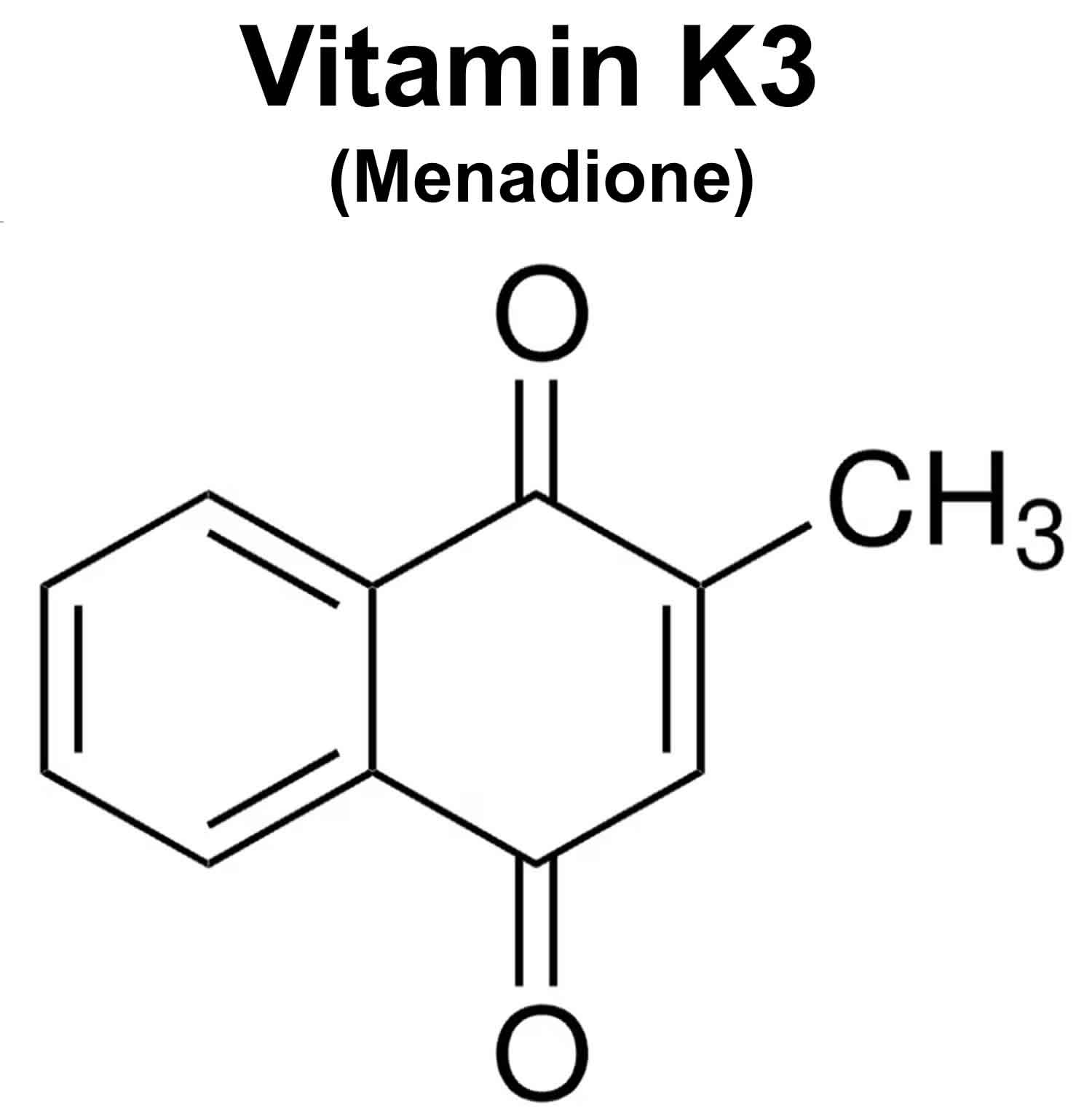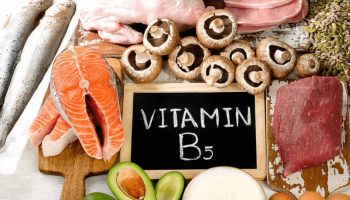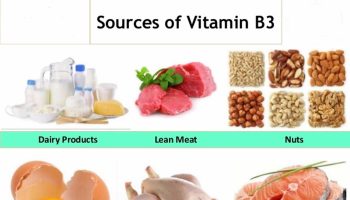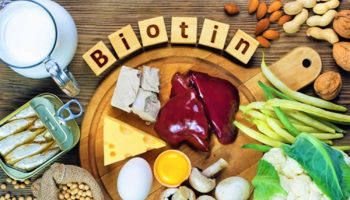Vitamin K3
Vitamin K3 also called menadione or 2-methyl-1,4-naphthoquinone is a man-made (synthetic) water soluble analogue of vitamin K (a family of compounds with a common chemical structure of 2-methyl-1,4-naphthoquinone that include vitamin K1 [phylloquinone] and a series of vitamin K2 [menaquinones] that is naturally present in some foods) that can be converted to vitamin K2 (menaquinone) in the intestine, but vitamin K3 is very toxic to humans that could result in allergic reactions, hemolytic anemia, liver damage, hyperbilirubinemia, and kernicterus (a form of severe brain damage that may produce decreased movement, loss of appetite, seizures, deafness, mental retardation, and even death) in the newborn, especially premature infants and as a result, has been banned in human dietary supplements in the United States because of its toxicity 1, 2, 3, 4, 5. Vitamin K3 or menadione was shown to damage liver cells in laboratory studies conducted during the 1980s and 1990s, so it is no longer used in dietary supplements or fortified foods 6, 2. Vitamin K3 (menadione) can interfere with the function of glutathione, one of the body’s natural antioxidants, resulting in oxidative damage to cell membranes. Menadione (vitamin K3) given by injection has induced liver injury, jaundice, hyperbilirubinemia, and hemolytic anemia (due to the rupture of red blood cells) in infants and kernicterus in infants; therefore, menadione (vitamin K3) is no longer used for treatment of vitamin K deficiency 3, 1, 7, 8, 9, 10. Therefore, only forms of vitamin K, vitamin K1 (phylloquinone) and vitamin K2 (menaquinone) are available as dietary supplements and prescription drugs.
Instead of consuming vitamin K3, the National Institutes of Health and other health authorities recommend getting the natural forms of vitamin K, which are vitamin K1 (phylloquinone) and vitamin K2 (menaquinones) designated as menaquinone-4 (MK-4) through menaquinone-13 (MK-13), based on the length of their side chain, with menaquinone-4 (MK-4), menaquinone-7 (MK-7), and menaquinone-9 (MK-9) are the most well-studied vitamin K2 (menaquinones) 11, 12, 1, 13, 14, 15. Vitamin K is a fat-soluble vitamin that your body needs to stay healthy. Vitamin K important for normal clotting of blood (the letter “K” in vitamin K is derived from the Danish word “koagulation”) and healthy bones (normal bone calcification) and also has other functions in your body. Prothrombin is a vitamin K-dependent protein directly involved with blood clotting. Osteocalcin is another protein that requires vitamin K to produce healthy bone tissue. If you are taking a blood thinner such as warfarin (Coumadin), it’s very important to get about the same amount of vitamin K each day.
Vitamin K is found naturally in many foods. You can get recommended amounts of vitamin K by eating a variety of foods, including the following 11, 12:
- Green leafy vegetables, such as spinach, kale, broccoli, and lettuce
- Vegetable oils
- Some fruits, such as blueberries and figs
- Meat, cheese, eggs, and soybeans
Small amounts can also be found in meat and dairy foods.
The National Academy of Medicine recommends that adult women should consume 90 mcg per day of vitamin K and 120 mcg vitamin K for men 11, 12. On the other hand, the European Food Safety Authority (EFSA) recommends that for all adults including pregnant and lactating women just need 70 mcg of vitamin K per day (1 μg/kg body weight per day for adults, based on the influence of vitamin K (phylloquinone) on blood coagulation) 16. These recommendations are based on the minimum amount of vitamin K needed to prevent signs of deficiency (bleeding). More research is needed in the future to determine the ideal amount of vitamin K to optimize bone health and prevent vascular calcification. Vitamin K is found throughout the body including the liver, brain, heart, pancreas, and bone. It is broken down very quickly and excreted in urine or stool. Because of this, it rarely reaches toxic levels in the body even with high intakes, as may sometimes occur with other fat-soluble vitamins.
Because vitamin K is found in many foods, it’s easy for people to get enough of this vitamin through their diet. Most U.S. diets contain an adequate amount of vitamin K 17. Data from the 2011–2012 National Health and Nutrition Examination Survey (NHANES) show that among children and teens age 2–19 years, the average daily vitamin K intake from foods is 66 mcg 18. In adults age 20 and older, the average daily vitamin K intake from foods is 122 mcg for women and 138 mcg for men. When both foods and supplements are considered, the average daily vitamin K intake increases to 164 mcg for women and 182 mcg for men.
In the United States, vitamin K3 (menadione) is used in poultry feed and some swine feeds as a source of vitamin K 4, 19. Vitamin K3 (menadione) is a provitamin that needs to be converted inside of the animal body to the active form of the vitamin K2 or menaquinone-4 (MK-4) to be active 15, 20. Vitamin K3 (menadione) is converted into menaquinone-4 (MK-4) in the endoplasmic reticulum, with UBIAD1 (UbiA prenyltransferase domain-containing protein 1) as the catalyst 15. As such, menaquinone-4 (MK-4) formed from vitamin K3 (menadione) is present in poultry and pork products in the U.S. food supply and is the primary dietary source of menaquinone-4 (MK-4) 10. Menaquinone-4 (MK-4) is present at high concentrations in human, poultry and pork tissues 21. Although humans generally obtain vitamin K1 (phylloquinone) and menaquinone-7 (MK-7) from the diet, intake of menaquinone-4 (MK-4) in animal foods is extremely low. Vitamin K3 (menadione), a synthetic vitamin K analog (Figure 2), is the primary source of vitamin K in poultry feed and some swine feeds, along with small amounts of phylloquinone (vitamin K1) 19. As such, MK-4 formed from vitamin K3 (menadione) is present in poultry and pork products in the U.S. food supply and is the primary dietary source of MK-4 10. Although menaquinone-4 (MK-4) is also formed from tissue-specific conversion of phylloquinone (vitamin K1) 22, the impact on dietary intake from this conversion is likely negligible as animal organs containing high MK-4 concentrations including kidney, brain, and pancreas, are not commonly consumed in most regions of the world. Menaquinone-4 (MK-4) is also found in modest amounts in milk, butter, and cheeses, which may make a small contribution to total vitamin K intake. The high consumption of poultry, pork, and dairy products in the United States 23, however, suggests that MK-4 may make a relevant contribution to total vitamin K intake. In regions where food systems do not use vitamin K3 (menadione) in animal feed or consumption of dairy products is low, MK-4 is most likely not an important dietary source of vitamin K. For example, MK-4 has been estimated to account for ∼3% of total vitamin K intake in the Netherlands 24 and is found in animal products in relatively lower amounts compared with the United States and Japan 21.
Menadione (vitamin K3) is involved as a cofactor in the posttranslational gamma-carboxylation of glutamic acid residues of certain proteins in the body. These proteins include the vitamin K-dependent coagulation factors II (prothrombin), VII (proconvertin), IX (Christmas factor), X (Stuart factor), protein C, protein S, protein Zv and a growth-arrest-specific factor (Gas6) 25, 26, 27. In contrast to the other vitamin K-dependent proteins in the blood coagulation cascade, protein C and protein S serve anticoagulant roles. The two vitamin K-dependent proteins found in bone are osteocalcin, also known as bone G1a (gamma-carboxyglutamate) protein or BGP, and the matrix G1a protein or MGP. Gamma-carboxylation is catalyzed by the vitamin K-dependent gamma-carboxylases. The reduced form of vitamin K, vitamin K hydroquinone, is the actual cofactor for the gamma-carboxylases. Proteins containing gamma-carboxyglutamate are called G1a proteins.
Figure 1. Chemical structures of vitamin K
Footnotes: Naturally occurring forms of vitamin K include vitamin K1 (phylloquinone) and vitamin K2 (menaquinones). Vitamin K1 or phylloquinone is synthesized by plants and can be found in such foods as spinach, broccoli, lettuce, and soybeans and is the predominant form in the diet. Vitamin K2 includes a range of vitamin K forms collectively referred to as menaquinones. These forms of vitamin K are designated menaquinone-n (MK-n), where n stands for the number of 5-carbon units in the side chain of the molecules (MK-2 to MK-13). Most menaquinones (vitamin K2) are primarily produced by bacteria in the human intestines and found in fermented foods and in animal products. Vitamin K3 (menadione), on the other hand, is one of the many manmade versions of vitamin K. Widely used in animal husbandry, vitamin K3 (menadione) is a provitamin that needs to be converted inside of the animal body to the active form of the vitamin K2 or menaquinone-4 (MK-4) to be active 15. Newborns that are administered too great a dosage of vitamin K3 (menadione) can suffer from kernicterus, a form of severe brain damage that may produce decreased movement, loss of appetite, seizures, deafness, mental retardation, and even death. Kernicterus is associated with an abnormally high concentration of bilirubin, a bile pigment, in the tissues of the brain, which can be caused by the presence of vitamin K3 (menadione). For this reason, menadione (vitamin K3) is no longer used for treatment of vitamin K deficiency 7.
[Source 28 ]Figure 2. Vitamin K3
Vitamin K3 safety
Vitamin K3 or Menadione has been banned in human dietary supplements in the United States because of its toxicity 1, 2, 3, 4. Vitamin K3 or menadione was shown to damage liver cells in laboratory studies conducted during the 1980s and 1990s, so it is no longer used in dietary supplements or fortified foods 6, 2. Vitamin K3 (menadione) can interfere with the function of glutathione, one of the body’s natural antioxidants, resulting in oxidative damage to cell membranes. Menadione (vitamin K3) given by injection has induced liver injury, jaundice, hyperbilirubinemia, and hemolytic anemia (due to the rupture of red blood cells) in infants and kernicterus in infants; therefore, menadione (vitamin K3) is no longer used for treatment of vitamin K deficiency 3, 1, 7, 8, 9, 10. Therefore, only forms of vitamin K, vitamin K1 (phylloquinone) and vitamin K2 (menaquinone) are available as dietary supplements and prescription drugs.
- Booth SL. Vitamin K: food composition and dietary intakes. Food Nutr Res. 2012;56. doi: 10.3402/fnr.v56i0.5505[↩][↩][↩][↩][↩]
- Imbrescia K, Moszczynski Z. Vitamin K. [Updated 2023 Jul 10]. In: StatPearls [Internet]. Treasure Island (FL): StatPearls Publishing; 2025 Jan-. Available from: https://www.ncbi.nlm.nih.gov/books/NBK551578[↩][↩][↩][↩]
- https://www.ema.europa.eu/en/documents/mrl-report/phytomenadione-vitamin-k1-and-menadione-vitamin-k3-summary-report-committee-veterinary-medicinal-products_en.pdf[↩][↩][↩][↩]
- Vitamin K Substances and Animal Feed. https://www.fda.gov/animal-veterinary/safe-feed/vitamin-k-substances-and-animal-feed[↩][↩][↩]
- Kaźmierczak-Barańska J, Karwowski BT. Vitamin K Contribution to DNA Damage-Advantage or Disadvantage? A Human Health Response. Nutrients. 2022 Oct 11;14(20):4219. doi: 10.3390/nu14204219[↩]
- Institute of Medicine (US) Panel on Micronutrients. Dietary Reference Intakes for Vitamin A, Vitamin K, Arsenic, Boron, Chromium, Copper, Iodine, Iron, Manganese, Molybdenum, Nickel, Silicon, Vanadium, and Zinc. Washington (DC): National Academies Press (US); 2001. Available from: https://www.ncbi.nlm.nih.gov/books/NBK222310[↩][↩]
- Mihatsch WA, Braegger C, Bronsky J, Campoy C, Domellöf M, Fewtrell M, Mis NF, Hojsak I, Hulst J, Indrio F, Lapillonne A, Mlgaard C, Embleton N, van Goudoever J; ESPGHAN Committee on Nutrition. Prevention of Vitamin K Deficiency Bleeding in Newborn Infants: A Position Paper by the ESPGHAN Committee on Nutrition. J Pediatr Gastroenterol Nutr. 2016 Jul;63(1):123-9. doi: 10.1097/MPG.0000000000001232[↩][↩][↩]
- Davidson RT, Foley AL, Engelke JA, Suttie JW. Conversion of dietary phylloquinone to tissue menaquinone-4 in rats is not dependent on gut bacteria. J Nutr. 1998 Feb;128(2):220-3. doi: 10.1093/jn/128.2.220[↩][↩]
- Thijssen HH, Vervoort LM, Schurgers LJ, Shearer MJ. Menadione is a metabolite of oral vitamin K. Br J Nutr. 2006 Feb;95(2):260-6. doi: 10.1079/bjn20051630[↩][↩]
- Elder SJ, Haytowitz DB, Howe J, Peterson JW, Booth SL. Vitamin k contents of meat, dairy, and fast food in the u.s. Diet. J Agric Food Chem. 2006 Jan 25;54(2):463-7. doi: 10.1021/jf052400h[↩][↩][↩][↩]
- Vitamin K. https://ods.od.nih.gov/factsheets/VitaminK-HealthProfessional[↩][↩][↩]
- Vitamin K. https://ods.od.nih.gov/factsheets/VitaminK-Consumer[↩][↩][↩]
- Ferland G. Vitamin K. In: Erdman JW, Macdonald IA, Zeisel SH, eds. Present Knowledge in Nutrition. 10th ed. Washington, DC: Wiley-Blackwell; 2012:230-47.[↩]
- Kidd PM. Vitamins D and K as pleiotropic nutrients: clinical importance to the skeletal and cardiovascular systems and preliminary evidence for synergy. Altern Med Rev. 2010 Sep;15(3):199-222.[↩]
- Nakagawa K, Hirota Y, Sawada N, Yuge N, Watanabe M, Uchino Y, Okuda N, Shimomura Y, Suhara Y, Okano T. Identification of UBIAD1 as a novel human menaquinone-4 biosynthetic enzyme. Nature. 2010 Nov 4;468(7320):117-21. doi: 10.1038/nature09464[↩][↩][↩][↩]
- EFSA Panel on Dietetic Products, Nutrition and Allergies (NDA); Turck D, Bresson JL, Burlingame B, Dean T, Fairweather-Tait S, Heinonen M, Hirsch-Ernst KI, Mangelsdorf I, McArdle HJ, Naska A, Nowicka G, Pentieva K, Sanz Y, Siani A, Sjödin A, Stern M, Tomé D, Van Loveren H, Vinceti M, Willatts P, Lamberg-Allardt C, Przyrembel H, Tetens I, Dumas C, Fabiani L, Ioannidou S, Neuhäuser-Berthold M. Dietary reference values for vitamin K. EFSA J. 2017 May 22;15(5):e04780. https://doi.org/10.2903/j.efsa.2017.4780[↩]
- Suttie JW. Vitamin K. In: Ross AC, Caballero B, Cousins RJ, Tucker KL, Ziegler TR, eds. Modern Nutrition in Health and Disease. 11th ed. Baltimore, MD: Lippincott Williams & Wilkins; 2014:305-16.[↩]
- https://www.ars.usda.gov/northeast-area/beltsville-md-bhnrc/beltsville-human-nutrition-research-center/food-surveys-research-group/docs/wweia-data-tables/[↩]
- Booth S. L. (2012). Vitamin K: food composition and dietary intakes. Food & nutrition research, 56, 10.3402/fnr.v56i0.5505. https://doi.org/10.3402/fnr.v56i0.5505[↩][↩]
- Okano T, Shimomura Y, Yamane M, Suhara Y, Kamao M, Sugiura M, et al. Conversion of phylloquinone (vitamin K1) into menaquinone-4 (vitamin K2) in mice: two possible routes for menaquinone-4 accumulation in cerebra of mice. J Biol Chem. 2008;283:11270–9. doi: 10.1074/jbc.M702971200[↩]
- Walther, B., Karl, J. P., Booth, S. L., & Boyaval, P. (2013). Menaquinones, bacteria, and the food supply: the relevance of dairy and fermented food products to vitamin K requirements. Advances in nutrition (Bethesda, Md.), 4(4), 463–473. https://doi.org/10.3945/an.113.003855[↩][↩]
- Okano T, Shimomura Y, Yamane M, Suhara Y, Kamao M, Sugiura M, Nakagawa K. Conversion of phylloquinone (Vitamin K1) into menaquinone-4 (Vitamin K2) in mice: two possible routes for menaquinone-4 accumulation in cerebra of mice. J Biol Chem. 2008 Apr 25;283(17):11270-9. doi: 10.1074/jbc.M702971200[↩]
- Wells HF, Buzby JC. Dietary assessment of major trends in U.S. food consumption, 1970–2005. Economic Information Bulletin No (EIB-33) p 27, March 2008.[↩]
- Gast GC, de Roos NM, Sluijs I, Bots ML, Beulens JW, Geleijnse JM, Witteman JC, Grobbee DE, Peeters PH, van der Schouw YT. A high menaquinone intake reduces the incidence of coronary heart disease. Nutr Metab Cardiovasc Dis. 2009 Sep;19(7):504-10. doi: 10.1016/j.numecd.2008.10.004[↩]
- Coutu D., Wu J.H., Monette A., Rivard G., Blostein M.D., Galipeau J. Periostin, a Member of a Novel Family of Vitamin K-dependent Proteins, Is Expressed by Mesenchymal Stromal Cells. J. Biol. Chem. 2008;283:17991–18001. doi: 10.1074/jbc.M708029200[↩]
- McCann J.C., Ames B.N. Vitamin K, an example of triage theory: Is micronutrient inadequacy linked to diseases of aging? Am. J. Clin. Nutr. 2009;90:889–907. doi: 10.3945/ajcn.2009.27930[↩]
- Lai Y., Masatoshi H., Ma Y., Guo Y., Zhang B. Role of Vitamin K in Intestinal Health. Front. Immunol. 2022;12:791565. doi: 10.3389/fimmu.2021.791565[↩]
- Vitamin K. https://lpi.oregonstate.edu/mic/vitamins/vitamin-K[↩]






